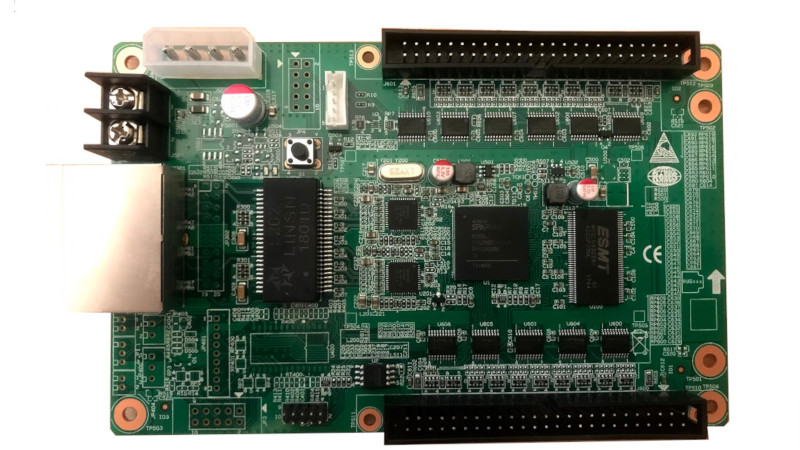Microcontrollers are a great way to learn about developing for embedded systems. However, once you outgrow their capabilities, FPGAs bring muscle that’s hard for even the fastest-clocked micros to match. If you’re doing anything with high-speed signals, loads of RAM, or something that requires lots of parallel calculation, you can’t go past FPGAs. Dev boards can be expensive, but there are alternatives. There’s a nifty project on Github trying to repurpose commodity hardware into a useful FPGA development platform.
Chubby75 is a project to reverse engineer the RV901T LED “Receiver Card”. This device is used to receive signals over Ethernet, and clock data out to large LED displays. This sort of work is highly processor intensive for microcontrollers, but a cinch for FPGAs to manage. The board packs a user-reprogrammable Spartan 6 FPGA, along with twin Gigabit Ethernet ports and 64MB of SDRAM. Thanks to the fact that its firmware is not locked down, it has the potential to be repurposed into all manner of other projects. The boards are available for under $30 USD, making them a prime target for thrifty hackers.
Thus far, the team have begun poring through the hardware documentation and are looking to develop a toolchain to allow the boards to be easily reprogrammed. With the right tools, these boards could be the next thing in cheap FPGAs, taking over when the Pano Logic thin clients become thin on the ground.
[Thanks to KAN for the tip!]
















Aren’t Spartan 6 boards, albeit without the Ethernet and perhaps less RAM, available for under $20 ? What else am I missing ?
It’s got a bunch of 5v IO lines and I’m not sure you can beat it on price if you want two gigabit Ethernet ports.
The cheapest I can find the rv901t on aliexpress is $20.02 with shipping. The cheapest Spartan 6 board I found is $19.80 with shipping and no external RAM. It seems worth paying $0.22 for the RAM and Ethernet.
You’d be much better off with a Pano Logic G2, with a Spartan-6 XC6SLX100 or XC6SLX150 FPGA. They usually sell for cheaper, too.
Very clever way of finding a FPGA development board without the ‘develompent firendly’ branding. +1 to this dude.
>64MB of SDRAM
8MB of ram
still fantastic board for the price, you get 2x GigE PHY and 64x bidirectional 5V buffered pins for free compared to cheapest ebay dev boards
Are the pins I/O or are they only O? there are 74HC245s doing the level converting, and they are only unidirectional and the direction depends on if the direction pin is set or not and the voltage the chip is powered with… On this board only some of them are direction controlled via the FPGA, the others are hardwired as outputs only. On the chips where the FPGA is controlling the direction, it appears the chips are still powered with +5V, which means they will output 5 volts to the FPGA which is not 5 volt tolerant (maybe they included voltage dividers? maybe not.) – the chips don’t do low level conversion without dropping Vcc to your desired low level. Without some hardware hacking, this thing is just a bunch of high speed GPOs… which is fine if that’s what you need i guess.
Yeah, 5V tolerance is something you *Really* need sorted in a Dev board.
There are several boards with Arduino headers, and even a 5V line to the right header pin, but no protection or level conversion.
A simple LCD panel can kill a very expensive FPGA very quickly if you’re not careful.
I’m glad I’m not the only one eying these boards as FPGA development boards.
Unfortunately the older models in my junkbox all have Spartan 3’s :/
does anyone know what the physical dimenions of these are?
Very interesting. I hadn’t seen Migen either before…
About 90x150x20mm
I saw it on Amazon with one day delivery for $30.
“Thus far, the team have begun poring through the hardware documentation and are looking to develop a toolchain to allow the boards to be easily reprogrammed. ”
Wonder how hard that is?
Maybe my sarcasm detector is on the fritz again and you’re joking? But not hard. A version of ISE (14ish) that still supports the Spartan 6 and a JTAG dongle I would be it I would imagine… I mean the “toolchain” is trivial here. Its the figuring out the original UCF and where all the x number of pins go that are being used for all the other onboard peripherals and how to interface with them where all the work would be.
I’m buying stock in the company and manufacturing facilities that make these. You guys keep buying all the boards you’ll never use. HaD, you keep driving up the price by hyping boards a bunch of people are going to make a run on that will forever be relegated to the “rainy day” parts bin.
Thank you from my bank account!
It’s surprising to me how every article like this makes me want to run out and buy one too, so I can be one of the ‘cool kids’. I’m only now getting mature enough to know I’ll likely never have time to play with this board. I’m much better off paying 10x so I don’t feel like it’s only $30, not a huge waste if I never get around to it.
Maybe the DSM-VI will have a label for people like us.
B^)
Best HaD comment ever.
Is there a forum for discussion about this board? I just received one the other day, my first purchase from AliExpress. I have started to draw (some of) the schematic in KiCad. Tomorrow I hope to wire up the JTAG pins and see if I can program the FPGA using my Xilinx programmer (which I haven’t yet used).